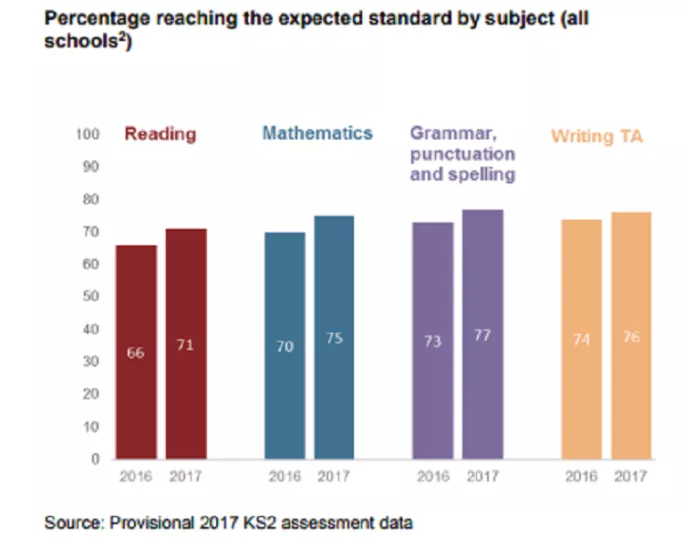- Home
- Sats: 61 per cent of pupils reach expected standard in three Rs
Sats: 61 per cent of pupils reach expected standard in three Rs

Today’s Sats results reveal that 61 per cent of children have reached the expected standard in reading, writing and mathematics.
The Department for Education’s provisional statistics show that results have risen since last year, when 53 per cent of pupils reached the expected standard in the three Rs.
More than half a million 10- and 11-year-olds took the tests in reading, maths and spelling, punctuation and grammar (Spag) in May. Writing is assessed by teachers against a national set of criteria, which lay out what children must do in order to reach the “expected standard”.
Todays’ results show that 71 per cent of pupils reached the expected standard in reading, up from 66 per cent last year.
More than three quarters - 77 per cent - of pupils reached the expected standard in the Spag tests, up from 72 per cent last year.
In mathematics, 75 per cent of pupils reached the expected standard, up from 70 per cent last year.
Writing, which is teacher assessed, has also seen a rise, with 76 per cent of pupils at the expected standard. That compares to 74 per cent of pupils last year, which was the first time that pupils’ writing scores had outperformed reading results.

But headteachers are concerned about the way the results are used to judge schools. Russell Hobby, general secretary of the NAHT headteachers’ union, said: “Currently, the methods to hold schools to account aren’t as fair or reliable as they should be. Sats data only gives parents part of the picture when judging a pupil’s success or a school’s effectiveness.”
The Sats statistics also allow comparisons between schools and pupils using a system of scaled scores - in which the raw scores from test papers are converted into a score from 80 to 120, where 100 denotes the expected standard.
This year, the average scaled score in reading was 104 - last year it was 103. In Spag, it was 106, whereas last year it was 104. In maths, it was 104, compared with 103 last year.
Today’s results are the first of several statistical publications that will analyse pupils’ performance in the Sats. The local authority results are due to be published in August.
Last year, the variation in writing results between local authorities prompted education data expert Dr Rebecca Allen to warn that it would be safer not to judge schools on the results.
Ofsted also urged its inspectors that the results should be interpreted “carefully” and education secretary Justine Greening later confirmed that no decisions on intervention would be made on the basis of 2016 data alone.
The floor standard thresholds - which are used to highlight which schools may require intervention - will be published in September, and the number of schools below the floor standards will be revealed in December when the performance tables are published.
The government has already said that “a broadly similar” proportion of schools will be below the floor standard compared to 2016, when 665 schools were below the floor standard.
The NAHT has renewed its call to scrap floor standards and coasting standards, saying they give too much weight to test data. “We need to remember that these results simply reflect how a small proportion of a school’s pupils performed in a one-off 45-minute test,” said James Bowen, director of NAHT Edge, which represents middle leaders.
In 2016, the first year of the controversial new Sats, the results were much lower than they had been under the old national curriculum. In 2015, 80 per cent of pupils achieved what was then the expected level 4 in reading, writing and maths.
Nick Gibb, minister for school standards, said: “Today’s results show sustained progress in reading, writing and maths and are a testament to the hard work of teachers and pupils across England. Thanks to their commitment and our new knowledge-rich curriculum, thousands more children will arrive at secondary school having mastered the fundamentals of reading, writing and maths, giving them the best start in life.”
For all the latest news and views on Sats, visit our specialised Sats hub.
Keep reading for just £1 per month
You've reached your limit of free articles this month. Subscribe for £1 per month for three months and get:
- Unlimited access to all Tes magazine content
- Exclusive subscriber-only stories
- Award-winning email newsletters



